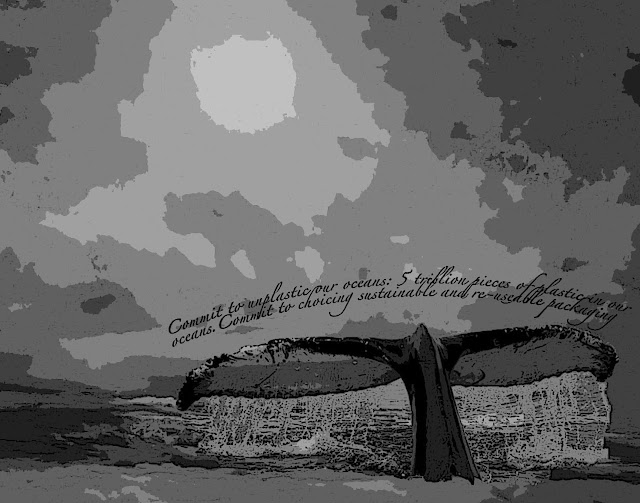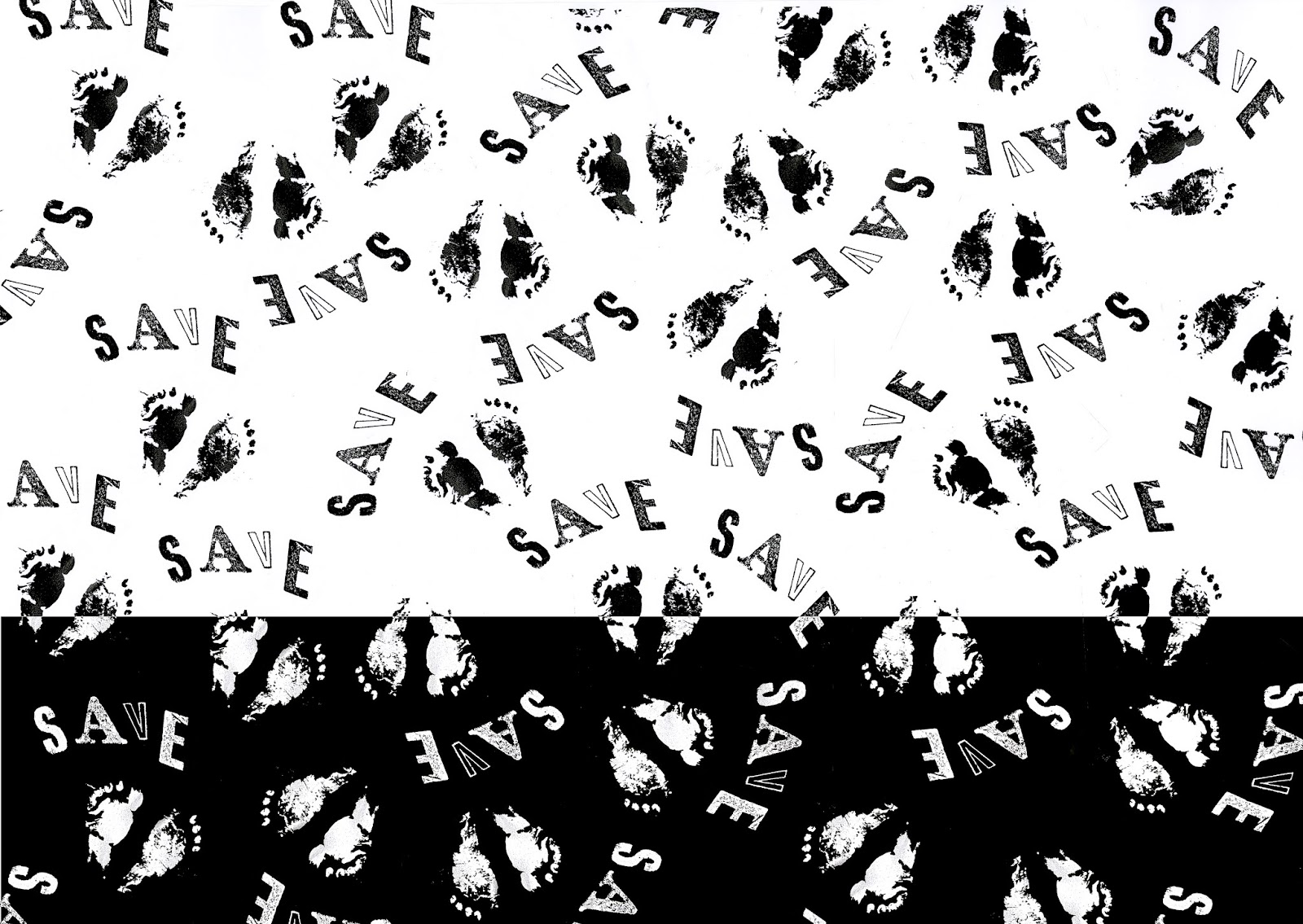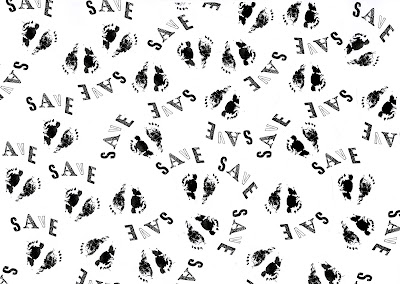Ecology Evolution: Foreward
Marketing Green Issues.
The reasoning behind this book has come from a comprehensive journal documenting a project brief of which includes some of the Ecology Evolution deliveriables for a Masters Degree in Design at University Lincoln 2019.
Extracts from my Design Journal.
Marketing ideas and current debates to encourage consumers to and viewers to seek a deeper understanding of ecology issues is part of the objective of my designing. These new and emerging strategies debates and current issues can be part of visual information on products including Wall Murals, fabrics, wall papers, tote bags and T shirts.
 |
| Hand Printed letters using old metal printing press alphabet. |
The objective is to give social impact in order to make my work relevant to social needs, recognising global warming and more specifically keeping our oceans clean through conservation campaign strategies within my practical work. Connecting with a number of nongovernmental groups to encourage a deeper meaning of social change through global knowledge of various campaigns including Antarctica Ocean Sanctuary currently run by Greenpeace.
Greenpeace is an environmental campaign organisation that is currently campaigning to prevent plastic pollution across our oceans, reducing plastic use via consumers is one way of doing this.
The Digital Revolution
"The digital revolution and it's subsequent technologies have transformed the fashion designers work.Together they form a whole new dimension from within which to create. In particular Adobe's Photoshop and illustrator programs have placed in their hands the tools they needed to bring textile design, traditionally a separate discipline, into their own studios." (Doe.T.2013.12). Collaboration between disciplines is a key advancement in design development and so is the creative collaboration between traditional and contemporary as "Philip Delamore, director of The Fashion Digital Studio based at \London College of Fashion. As a practicing textile designer he has experienced the entire digital print revolution."Early on, I was working on digital prints as a consultant for designers.I would often have to un-digitize them- try to achieve a screen print look with the technique-because digital print was regarded as inferior and that wasn't what designers were looking for.The full blown digital aesthetics look to a long time to develop." (Doe.T.2013.12.)
Integrating traditional and digital textiles bridges a gap between industrial visions and traditional crafts. " One of the main issues of design is its use and how it is respected cultivated and progressed through time(product use and usability). In late industrial capitalism, designed, artifacts and the experience of them are sites through which people , to different degrees, live facets of their lives. People live and dream through design. Designed artifacts are, in this sense, materialized ideologies”(Laurel.2003.26).
As Dalke points out "Interdisciplinary is not a place to be reached but rather a commitment to a process of continually testing the value parts, experimenting with different ways they might be combined to make wholes, and using the resulting wholes to refigure the parts"(Dalke et el 2006:7).
Within my dissemination I can see links from my multi faceted project with my numerous test projects that a desire to collaborate different techniques not only to evaluate which is the most eco friendly but also to acknowledge and understand the attributes of each process within one collection in order to add interest and uniqueness . I have learnt from my project 'Ecology Evolution' is how important the journey through researching visual imagery and theory is as important and even more so than the actual completed achieved designs. The end products I have created linked intruitivily to the 'why',that is the desire to improve the ecology of the world through knowledge distrubution andd serve as examples of how design can inheret value and meaning for a broader subject.
"Liberty has been at the for front of commercial and art textile printing since the late nineteenth century. During that time it has collaborated with many designers, from Bill Blass to Vivienne Westwood. Emma Mawston, head designer at Liberty fabrics, beleves there is a place for a variety of techniques, so long as they are treated with equally high standards in terms of print mark and colour matching, as well as design. "I think digital printing and screen printing work wonderfully together in a collection enabling different effects and designs to be created. There are colours and tints that are not able to be created digitally only with screen printing and obviously vice versa" (Doe.T.2013.15)
Extract from Ecology Evolution Design Journal.
Image on forward pages we're created on photoshop using a basic effects button. This may well be useful for screen printing imagery on to paper and fabric.
Adding text to explain damage via plastic pollution, lettering could be bolder using different text would work better.
Greenpeace is an environmental campaign organisation that is currently campaigning to prevent plastic pollution across our oceans, reducing plastic use via consumers is one way of doing this.
The Digital Revolution
"The digital revolution and it's subsequent technologies have transformed the fashion designers work.Together they form a whole new dimension from within which to create. In particular Adobe's Photoshop and illustrator programs have placed in their hands the tools they needed to bring textile design, traditionally a separate discipline, into their own studios." (Doe.T.2013.12). Collaboration between disciplines is a key advancement in design development and so is the creative collaboration between traditional and contemporary as "Philip Delamore, director of The Fashion Digital Studio based at \London College of Fashion. As a practicing textile designer he has experienced the entire digital print revolution."Early on, I was working on digital prints as a consultant for designers.I would often have to un-digitize them- try to achieve a screen print look with the technique-because digital print was regarded as inferior and that wasn't what designers were looking for.The full blown digital aesthetics look to a long time to develop." (Doe.T.2013.12.)
Integrating traditional and digital textiles bridges a gap between industrial visions and traditional crafts. " One of the main issues of design is its use and how it is respected cultivated and progressed through time(product use and usability). In late industrial capitalism, designed, artifacts and the experience of them are sites through which people , to different degrees, live facets of their lives. People live and dream through design. Designed artifacts are, in this sense, materialized ideologies”(Laurel.2003.26).
As Dalke points out "Interdisciplinary is not a place to be reached but rather a commitment to a process of continually testing the value parts, experimenting with different ways they might be combined to make wholes, and using the resulting wholes to refigure the parts"(Dalke et el 2006:7).
Within my dissemination I can see links from my multi faceted project with my numerous test projects that a desire to collaborate different techniques not only to evaluate which is the most eco friendly but also to acknowledge and understand the attributes of each process within one collection in order to add interest and uniqueness . I have learnt from my project 'Ecology Evolution' is how important the journey through researching visual imagery and theory is as important and even more so than the actual completed achieved designs. The end products I have created linked intruitivily to the 'why',that is the desire to improve the ecology of the world through knowledge distrubution andd serve as examples of how design can inheret value and meaning for a broader subject.
"Liberty has been at the for front of commercial and art textile printing since the late nineteenth century. During that time it has collaborated with many designers, from Bill Blass to Vivienne Westwood. Emma Mawston, head designer at Liberty fabrics, beleves there is a place for a variety of techniques, so long as they are treated with equally high standards in terms of print mark and colour matching, as well as design. "I think digital printing and screen printing work wonderfully together in a collection enabling different effects and designs to be created. There are colours and tints that are not able to be created digitally only with screen printing and obviously vice versa" (Doe.T.2013.15)
Extract from Ecology Evolution Design Journal.
Image on forward pages we're created on photoshop using a basic effects button. This may well be useful for screen printing imagery on to paper and fabric.
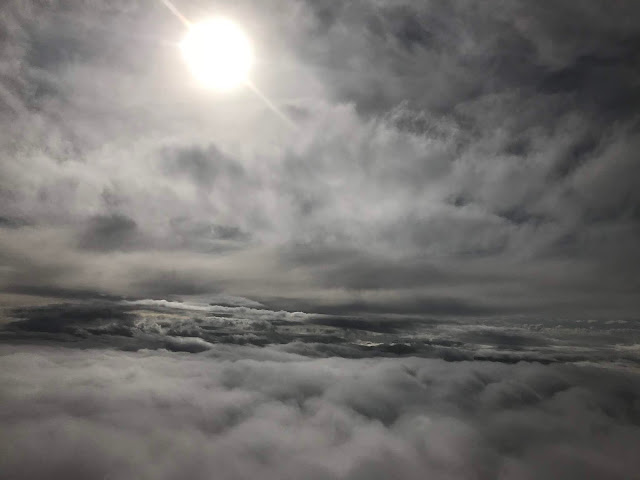 |
| Photograph taken while flying across Europe. |
 |
| Whale tail fabric full width plus repeated for fabric roll production. |
These fabrics were produced digitally through research within my dissemination I have realised even though currently Memaki digital fabric printers don't use eco conscious inks>However they use less ink than traditional print making " One factor that my determine where printing develops more generally is its environmental footprint. The digital printing process uses half the ink of screen printing methods and results in less waste being discharged.There is also no washing of screens or changing colours, so water consumption is reduced by almost half"(Doe.T.2013.13) The down side is the obsoleting aspect of machinery, new digital machines are constantly being designed for the industry , it isn't unusual for fabric companies to replace their machines every year. I am assuming their old machines would be sold off to other companies to reduce the impact on global waste.Otherwise an awful lot of machine waste finding itself in landfil and possibly inappropriate dumped in areas of the world, polluting our natural world.
 |
| Scale developments |
 |
| Digital printing onto silk. |
Velvet repeat whale tail.
| Digital printing onto velvet. |
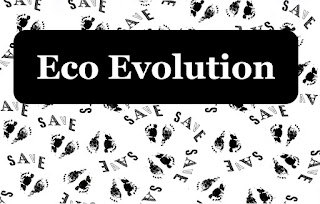 |
| Screen printing using photoshop. |
| Section from one of my sketch books. |
| Screen for printing paper card headers for fabric swatches. |
| Mixing colour inks for screen printing. |
Created a really nice putty and deep navy for headers and swing tickets. Using up cycled newspaper print paper for packaging.
| Printed paper with header and swing tickets. |
